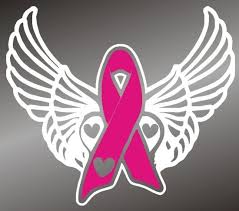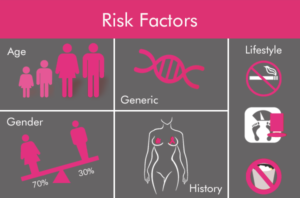First Part of risk factors:
Those that we cannot change:
Gender
Women account for more than 99 percent of all breast cancer cases.
Age
After gender, age is the most influential risk factor for developing breast cancer. Women younger than age 40 account for only 4.7 percent of invasive breast cancer diagnoses and only 3.6 percent of in situ breast cancer diagnoses. Over 70 percent of all breast cancer diagnoses are made in women who are 50 or older.
You may have heard the statistic that one in eight women in the United States will develop breast cancer. This does not mean that a woman of any age has a one-in-eight chance of developing breast cancer. This statistic conveys a woman’s lifetime risk. This means that if a woman lives until age 85, she has a risk of one in eight of developing breast cancer sometime during her lifetime.
Race
After age 40, Caucasian women are more likely to be diagnosed with breast cancer than African-American women. However, African-American women are more likely than white women to die of breast cancer. Women of Asian, Hispanic or American Indian descent are at lower risk than Caucasian or African-American women for developing breast cancer.
Personal History
If a woman has had cancer in one breast, she is at increased risk of developing cancer in the other breast.
Family History
Women with a relative who has had breast cancer are at higher risk of developing breast cancer themselves, particularly if it is a first-degree relative, such as a mother, sister or daughter.
That risk is further increased if a woman has multiple first-degree relatives who have had breast cancer, or if she has a first-degree relative who developed breast cancer at a young age or in both breasts.
Patients with family members who have had breast and/or ovarian cancer may choose to see a qualified genetic counselor from the UCSF Cancer Genetics and Prevention Program at Mount Zion. These counselors are available to evaluate a person’s likelihood of carrying a gene mutation and to discuss the possibility of genetic testing.
Genetic Risk Factors
Women who have certain inherited gene mutations (including BRCA1 and BRCA2) have a significantly increased risk of breast cancer and account for about 5 percent to 10 percent of breast cancer cases. In most women, the normally functioning BRCA1 and BRCA2 genes help to prevent breast cancer by controlling cell growth. However, these genes are no longer able to control cell growth properly unmutated.
Since these genes are passed down from your parents, it is possible to carry a gene mutation from the mother or father’s side of the family. A female who carries either the BRCA1 or BRCA2 gene mutation has up to an 85 percent chance of developing breast cancer by the age of 70. However, in men the BRCA2 gene mutation is reported to increase risk of breast cancer more than the BRCA1 gene mutation. Males who carry the BRCA2 gene mutation have a suggested 6 percent chance of developing breast cancer during a lifetime.
A prevalence of the BRCA1 and BRCA2 gene mutations has been observed in the Ashkenazi Jewish (Jews with European or Central European ancestry) population. Having one or more relatives with breast or ovarian cancer, and being of Ashkenazi Jewish descent, puts a person at greater risk for carrying a BRCA gene mutation.
Radiation
Exposure to high doses of chest radiation, such as for medical therapy for Hodgkin’s lymphoma, particularly during childhood, can greatly increase a woman’s risk of developing breast cancer.
Researchers have found that the age at which radiation was received is inversely related to the acquired risk. Thus, women who received radiation after their menopausal years incurred very little risk.

